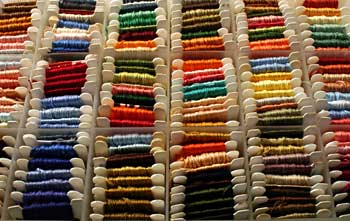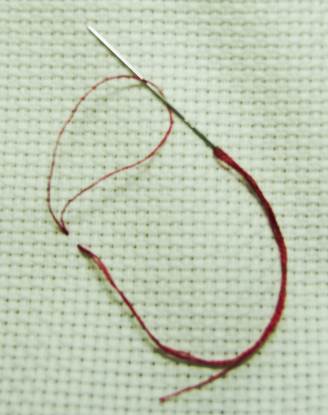How to Make a Whole Cloth Baby Quilt With Embroidery
- Home
- What exercise I need?
- Embroidery Floss
Using Embroidery floss - the nuts
Embroidery floss comes in all the colors of the rainbow, and more as well, but there are certain bones techniques nosotros need to principal when using it, such as...

- how many strands of floss to use on different count fabrics,
- how to carve up each strand (see video below)
- how to use rayon embroidery thread
- how to begin without a knot
- using a waste knot
- using an away waste knot
- how to fasten off
- how to keep your floss tidy and organized
- what size needle to utilise
Y'all likely have many more questions nearly embroidery floss and other fibres. At the end of this page is a form you can utilize to ask those questions. Either myself, or other visitors to the site, will try to answer them for you. Merely permit'south beginning with the nigh important facts about using these threads.
Is information technology worth economizing?
When you consider the hours yous volition spend on a needlework project, and so you lot volition run into why information technology is important to utilize first-class quality hand embroidery thread. Economizing here is not a good idea.
There are many reputable floss manufacturers such as DMC, Anchor, Madeira and Susan Bates. Each company will apply its own numbering system and near counted cantankerous run up patterns will list the colors needed using 1, or perhaps more than, of these.
You lot can use an embroidery thread conversion chart to find the nearest equivalent in another manufacturer's shade menu, but it is best non to mix dissimilar brands in ane project, unless the designer stipulates this.
Separating one strand of floss
Six stranded cotton fiber embroidery floss needs to be separated earlier use. It is rare to use all half-dozen strands together in the needle at in one case.
So let'southward kickoff with a unproblematic technique for taking one strand out of the skein without getting in a tangle. This one technique can save yous loads of frustration.
At my classes I accept seen people use their easily, teeth, elbows and other body parts to do this, and they can't believe how piece of cake it can be when yous know how. The following video shows a simple way that tin save time and frustration. If you demand to utilise two strands, only repeat!
How many strands of embroidery floss to utilize
This will depend on what fabric count you are stitching on, or the effect you are trying to achieve. The post-obit tabular array will help when cross stitching on Aida or evenweave fabrics.
| Cloth count 11 fourteen 16 18 28 (over 2 threads) 32 (over 2 threads) 36 (over 2 threads) | Number of strands 3 ii or 3 three 1 or 2 ii one or 2 1 |
If you lot are working on effectively fabrics, such as 40 count silk gauze, and so use just one strand and just stitch the first leg of the cross run up, in effect working in petit bespeak.
If you are embroidering the seams on a crazy quilt block y'all may wish to utilise more strands to brand the stitches more prominent.
How to secure your embroidery floss when starting
One of the most common questions I am asked at classes is "Can I start with a knot?".
Information technology is best to avoid knots if possible. Firstly they can cause an unsightly bump on the dorsum of your work, and secondly knots can come undone!

And then how tin can we secure that loose end?
There is an easy, neat manner of starting a piece of floss if you need to use 2 strands, calledthe loop method.
However, there is a drawback to it.
Be certain yous can count accurately before yous use it! It makes a secure starting point, merely one that is difficult to undo.
I always suggest new students get out the loose ends free for a while until they are sure they have placed their stitches in the correct position. If they brand a fault, and the error is near the beginning of the piece of floss (as my mistakes usually are), it may be easier to unpick a few stitches from the start rather than taking the yarn all the fashion dorsum from the current position.
Beginning by stripping one strand from the 6 stranded cotton. Cutting it twice the length you would normally sew together with. I find around 28-xxx" is a suitable length.
Bring both ends together, folding the length of thread in one-half. Thread these ends through your needle, leaving a loop at the other end.
Push the needle through the material from the back, leaving the loop hanging loose. Take the needle to the back of the fabric and pass it through the loop before pulling tight. There you are, a neat, secure starting point. The photo shows the contrary side of the work.
The second method of starting is again to cut ii lengths of embroidery floss twice the normal length you would sew with. Exercise not fold them in one-half this time.
Pick your starting point and pull but half of the thread through the fabric. Leave the other half for later.
I find it helps to pop this stop into a spare needle and bring information technology through the fabric at the border of the piece of work and "park" it at that place for the fourth dimension existence. This keeps it out of the way so information technology doesn't get tangled on the back.
With your commencement needle, piece of work your stitches until you run out of cotton wool. And so return to the other needle and continue stitching. This method reduces the number of fastening on operations you need to exercise, which keeps the reverse of the work neater.
Starting with a waste Knot
As I mentioned before, on occasions it is OK to kickoff with a knot.
After knotting the end, push the needle through the textile from the FRONT of the piece of work, leaving the knot sitting on the surface a few inches away in the direction that y'all volition exist stitching.
Bring the needle back through to the front in the correct position to sew together and piece of work over the first few stitches over the end of the thread.
After a few stitches you lot will snip off the knot, leaving the cease neatly secured.
Starting with an abroad waste material knot
Similar to the method above, for an away waste material knot you bring the needle to the front of the work away from the direction of stitching.
When the knot is after cut off, you will demand to thread the needle with this end, and fasten information technology into the back of the stitches.
You volition often use this technique in hardanger or pulled work where yous don't desire to take chances the end showing underneath open areas of the blueprint.
Fastening off your embroidery floss
The neatest fashion of fastening off is to weave the loose end under half a dozen stitches on the back of the work and then cut information technology off close to the stitching.
Ask a question nigh threads and fibres
At that place is a vast array of threads available to stitch with nowadays. If you have whatsoever questions on how to utilize them, please use the grade below.
What Other Visitors Accept Asked
Click below to see contributions from other visitors to this page...
Keep in Touch with Stitchin'Times Newsletter
- Home
- What do I need?
- Embroidery Floss
Source: https://www.needlework-tips-and-techniques.com/embroidery-floss.html
0 Response to "How to Make a Whole Cloth Baby Quilt With Embroidery"
إرسال تعليق